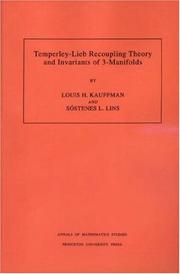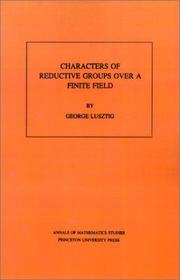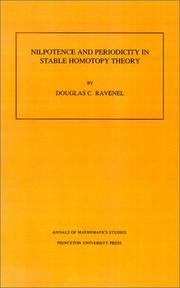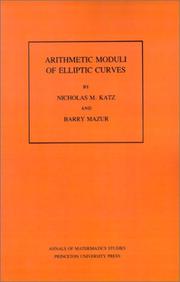| Listing 1 - 7 of 7 |
Sort by
|

ISBN: 0691036411 0691036403 1400882532 9780691036403 9780691036410 Year: 2016 Volume: 134 Publisher: Princeton, NJ : Princeton University Press,
Abstract | Keywords | Export | Availability | Bookmark
 Loading...
Loading...Choose an application
- Reference Manager
- EndNote
- RefWorks (Direct export to RefWorks)
This book offers a self-contained account of the 3-manifold invariants arising from the original Jones polynomial. These are the Witten-Reshetikhin-Turaev and the Turaev-Viro invariants. Starting from the Kauffman bracket model for the Jones polynomial and the diagrammatic Temperley-Lieb algebra, higher-order polynomial invariants of links are constructed and combined to form the 3-manifold invariants. The methods in this book are based on a recoupling theory for the Temperley-Lieb algebra. This recoupling theory is a q-deformation of the SU(2) spin networks of Roger Penrose. The recoupling theory is developed in a purely combinatorial and elementary manner. Calculations are based on a reformulation of the Kirillov-Reshetikhin shadow world, leading to expressions for all the invariants in terms of state summations on 2-cell complexes. Extensive tables of the invariants are included. Manifolds in these tables are recognized by surgery presentations and by means of 3-gems (graph encoded 3-manifolds) in an approach pioneered by Sostenes Lins. The appendices include information about gems, examples of distinct manifolds with the same invariants, and applications to the Turaev-Viro invariant and to the Crane-Yetter invariant of 4-manifolds.
Drie-menigvuldigheden (Topologie) --- Knopentheorie --- Knot theory --- Noeuds [Theorie des ] --- Three-manifolds (Topology) --- Trois-variétés (Topologie) --- Knot theory. --- Algebraic topology --- Invariants --- Mathematics --- Invariants (Mathematics) --- Invariants. --- 3-manifolds (Topology) --- Manifolds, Three dimensional (Topology) --- Three-dimensional manifolds (Topology) --- Low-dimensional topology --- Topological manifolds --- Knots (Topology) --- 3-manifold. --- Addition. --- Algorithm. --- Ambient isotopy. --- Axiom. --- Backslash. --- Barycentric subdivision. --- Bijection. --- Bipartite graph. --- Borromean rings. --- Boundary parallel. --- Bracket polynomial. --- Calculation. --- Canonical form. --- Cartesian product. --- Cobordism. --- Coefficient. --- Combination. --- Commutator. --- Complex conjugate. --- Computation. --- Connected component (graph theory). --- Connected sum. --- Cubic graph. --- Diagram (category theory). --- Dimension. --- Disjoint sets. --- Disjoint union. --- Elaboration. --- Embedding. --- Equation. --- Equivalence class. --- Explicit formula. --- Explicit formulae (L-function). --- Factorial. --- Fundamental group. --- Graph (discrete mathematics). --- Graph embedding. --- Handlebody. --- Homeomorphism. --- Homology (mathematics). --- Identity element. --- Intersection form (4-manifold). --- Inverse function. --- Jones polynomial. --- Kirby calculus. --- Line segment. --- Linear independence. --- Matching (graph theory). --- Mathematical physics. --- Mathematical proof. --- Mathematics. --- Maxima and minima. --- Monograph. --- Natural number. --- Network theory. --- Notation. --- Numerical analysis. --- Orientability. --- Orthogonality. --- Pairing. --- Pairwise. --- Parametrization. --- Parity (mathematics). --- Partition function (mathematics). --- Permutation. --- Poincaré conjecture. --- Polyhedron. --- Quantum group. --- Quantum invariant. --- Recoupling. --- Recursion. --- Reidemeister move. --- Result. --- Roger Penrose. --- Root of unity. --- Scientific notation. --- Sequence. --- Significant figures. --- Simultaneous equations. --- Smoothing. --- Special case. --- Sphere. --- Spin network. --- Summation. --- Symmetric group. --- Tetrahedron. --- The Geometry Center. --- Theorem. --- Theory. --- Three-dimensional space (mathematics). --- Time complexity. --- Tubular neighborhood. --- Two-dimensional space. --- Vector field. --- Vector space. --- Vertex (graph theory). --- Winding number. --- Writhe.

ISBN: 0691083509 0691083517 1400881773 9780691083513 9780691083506 Year: 2016 Volume: 107 Publisher: Princeton, NJ : Princeton University Press,
Abstract | Keywords | Export | Availability | Bookmark
 Loading...
Loading...Choose an application
- Reference Manager
- EndNote
- RefWorks (Direct export to RefWorks)
This book presents a classification of all (complex)irreducible representations of a reductive group withconnected centre, over a finite field. To achieve this,the author uses etale intersection cohomology, anddetailed information on representations of Weylgroups.
512 --- Characters of groups --- Finite fields (Algebra) --- Finite groups --- Groups, Finite --- Group theory --- Modules (Algebra) --- Modular fields (Algebra) --- Algebra, Abstract --- Algebraic fields --- Galois theory --- Characters, Group --- Group characters --- Groups, Characters of --- Representations of groups --- Rings (Algebra) --- Algebra --- 512 Algebra --- Finite groups. --- Characters of groups. --- Addition. --- Algebra representation. --- Algebraic closure. --- Algebraic group. --- Algebraic variety. --- Algebraically closed field. --- Bijection. --- Borel subgroup. --- Cartan subalgebra. --- Character table. --- Character theory. --- Characteristic function (probability theory). --- Characteristic polynomial. --- Class function (algebra). --- Classical group. --- Coefficient. --- Cohomology with compact support. --- Cohomology. --- Combination. --- Complex number. --- Computation. --- Conjugacy class. --- Connected component (graph theory). --- Coxeter group. --- Cyclic group. --- Cyclotomic polynomial. --- David Kazhdan. --- Dense set. --- Derived category. --- Diagram (category theory). --- Dimension. --- Direct sum. --- Disjoint sets. --- Disjoint union. --- E6 (mathematics). --- Eigenvalues and eigenvectors. --- Endomorphism. --- Equivalence class. --- Equivalence relation. --- Existential quantification. --- Explicit formula. --- Explicit formulae (L-function). --- Fiber bundle. --- Finite field. --- Finite group. --- Fourier transform. --- Green's function. --- Group (mathematics). --- Group action. --- Group representation. --- Harish-Chandra. --- Hecke algebra. --- Identity element. --- Integer. --- Irreducible representation. --- Isomorphism class. --- Jordan decomposition. --- Line bundle. --- Linear combination. --- Local system. --- Mathematical induction. --- Maximal torus. --- Module (mathematics). --- Monodromy. --- Morphism. --- Orthonormal basis. --- P-adic number. --- Parametrization. --- Parity (mathematics). --- Partially ordered set. --- Perverse sheaf. --- Pointwise. --- Polynomial. --- Quantity. --- Rational point. --- Reductive group. --- Ree group. --- Schubert variety. --- Scientific notation. --- Semisimple Lie algebra. --- Sheaf (mathematics). --- Simple group. --- Simple module. --- Special case. --- Standard basis. --- Subset. --- Subtraction. --- Summation. --- Surjective function. --- Symmetric group. --- Tensor product. --- Theorem. --- Two-dimensional space. --- Unipotent representation. --- Vector bundle. --- Vector space. --- Verma module. --- Weil conjecture. --- Weyl group. --- Zariski topology.

ISBN: 069108792X 069102572X 1400882486 9780691025728 9780691087924 Year: 2016 Volume: 128 Publisher: Princeton, NJ : Princeton University Press,
Abstract | Keywords | Export | Availability | Bookmark
 Loading...
Loading...Choose an application
- Reference Manager
- EndNote
- RefWorks (Direct export to RefWorks)
Nilpotence and Periodicity in Stable Homotopy Theory describes some major advances made in algebraic topology in recent years, centering on the nilpotence and periodicity theorems, which were conjectured by the author in 1977 and proved by Devinatz, Hopkins, and Smith in 1985. During the last ten years a number of significant advances have been made in homotopy theory, and this book fills a real need for an up-to-date text on that topic. Ravenel's first few chapters are written with a general mathematical audience in mind. They survey both the ideas that lead up to the theorems and their applications to homotopy theory. The book begins with some elementary concepts of homotopy theory that are needed to state the problem. This includes such notions as homotopy, homotopy equivalence, CW-complex, and suspension. Next the machinery of complex cobordism, Morava K-theory, and formal group laws in characteristic p are introduced. The latter portion of the book provides specialists with a coherent and rigorous account of the proofs. It includes hitherto unpublished material on the smash product and chromatic convergence theorems and on modular representations of the symmetric group.
Homotopie --- Homotopy theory --- Homotopy theory. --- Deformations, Continuous --- Topology --- Abelian category. --- Abelian group. --- Adams spectral sequence. --- Additive category. --- Affine space. --- Algebra homomorphism. --- Algebraic closure. --- Algebraic structure. --- Algebraic topology (object). --- Algebraic topology. --- Algebraic variety. --- Algebraically closed field. --- Atiyah–Hirzebruch spectral sequence. --- Automorphism. --- Boolean algebra (structure). --- CW complex. --- Canonical map. --- Cantor set. --- Category of topological spaces. --- Category theory. --- Classification theorem. --- Classifying space. --- Cohomology operation. --- Cohomology. --- Cokernel. --- Commutative algebra. --- Commutative ring. --- Complex projective space. --- Complex vector bundle. --- Computation. --- Conjecture. --- Conjugacy class. --- Continuous function. --- Contractible space. --- Coproduct. --- Differentiable manifold. --- Disjoint union. --- Division algebra. --- Equation. --- Explicit formulae (L-function). --- Functor. --- G-module. --- Groupoid. --- Homology (mathematics). --- Homomorphism. --- Homotopy category. --- Homotopy group. --- Homotopy. --- Hopf algebra. --- Hurewicz theorem. --- Inclusion map. --- Infinite product. --- Integer. --- Inverse limit. --- Irreducible representation. --- Isomorphism class. --- K-theory. --- Loop space. --- Mapping cone (homological algebra). --- Mathematical induction. --- Modular representation theory. --- Module (mathematics). --- Monomorphism. --- Moore space. --- Morava K-theory. --- Morphism. --- N-sphere. --- Noetherian ring. --- Noetherian. --- Noncommutative ring. --- Number theory. --- P-adic number. --- Piecewise linear manifold. --- Polynomial ring. --- Polynomial. --- Power series. --- Prime number. --- Principal ideal domain. --- Profinite group. --- Reduced homology. --- Ring (mathematics). --- Ring homomorphism. --- Ring spectrum. --- Simplicial complex. --- Simply connected space. --- Smash product. --- Special case. --- Spectral sequence. --- Steenrod algebra. --- Sub"ient. --- Subalgebra. --- Subcategory. --- Subring. --- Symmetric group. --- Tensor product. --- Theorem. --- Topological space. --- Topology. --- Vector bundle. --- Zariski topology.
Book
ISBN: 0691079994 1400881986 9780691079998 Year: 2016 Volume: 38 Publisher: Princeton, NJ : Princeton University Press,
Abstract | Keywords | Export | Availability | Bookmark
 Loading...
Loading...Choose an application
- Reference Manager
- EndNote
- RefWorks (Direct export to RefWorks)
The description for this book, Linear Inequalities and Related Systems. (AM-38), Volume 38, will be forthcoming.
Operational research. Game theory --- Linear programming. --- Matrices. --- Game theory. --- Games, Theory of --- Theory of games --- Mathematical models --- Mathematics --- Algebra, Matrix --- Cracovians (Mathematics) --- Matrix algebra --- Matrixes (Algebra) --- Algebra, Abstract --- Algebra, Universal --- Production scheduling --- Programming (Mathematics) --- Banach space. --- Basic solution (linear programming). --- Big O notation. --- Bilinear form. --- Boundary (topology). --- Brouwer fixed-point theorem. --- Characterization (mathematics). --- Coefficient. --- Combination. --- Computation. --- Computational problem. --- Convex combination. --- Convex cone. --- Convex hull. --- Convex set. --- Corollary. --- Correlation and dependence. --- Cramer's rule. --- Cyclic permutation. --- Dedekind cut. --- Degeneracy (mathematics). --- Determinant. --- Diagram (category theory). --- Dilworth's theorem. --- Dimension (vector space). --- Directional derivative. --- Disjoint sets. --- Doubly stochastic matrix. --- Dual space. --- Duality (mathematics). --- Duality (optimization). --- Eigenvalues and eigenvectors. --- Elementary proof. --- Equation solving. --- Equation. --- Equivalence class. --- Euclidean space. --- Existence theorem. --- Existential quantification. --- Extreme point. --- Fixed-point theorem. --- Functional analysis. --- Fundamental theorem. --- General equilibrium theory. --- Hall's theorem. --- Hilbert space. --- Incidence matrix. --- Inequality (mathematics). --- Infimum and supremum. --- Invertible matrix. --- Kakutani fixed-point theorem. --- Lagrange multiplier. --- Linear equation. --- Linear inequality. --- Linear map. --- Linear space (geometry). --- Linear subspace. --- Loss function. --- Main diagonal. --- Mathematical induction. --- Mathematical optimization. --- Mathematical problem. --- Max-flow min-cut theorem. --- Maxima and minima. --- Maximal set. --- Maximum flow problem. --- Menger's theorem. --- Minor (linear algebra). --- Monotonic function. --- N-vector. --- Nonlinear programming. --- Nonnegative matrix. --- Parity (mathematics). --- Partially ordered set. --- Permutation matrix. --- Permutation. --- Polyhedron. --- Quantity. --- Representation theorem. --- Row and column vectors. --- Scientific notation. --- Sensitivity analysis. --- Set notation. --- Sign (mathematics). --- Simplex algorithm. --- Simultaneous equations. --- Solution set. --- Special case. --- Subset. --- Summation. --- System of linear equations. --- Theorem. --- Transpose. --- Unit sphere. --- Unit vector. --- Upper and lower bounds. --- Variable (mathematics). --- Vector space. --- Von Neumann's theorem.

ISBN: 0691083525 0691083495 1400881714 Year: 2016 Publisher: Princeton, NJ : Princeton University Press,
Abstract | Keywords | Export | Availability | Bookmark
 Loading...
Loading...Choose an application
- Reference Manager
- EndNote
- RefWorks (Direct export to RefWorks)
This work is a comprehensive treatment of recent developments in the study of elliptic curves and their moduli spaces. The arithmetic study of the moduli spaces began with Jacobi's "Fundamenta Nova" in 1829, and the modern theory was erected by Eichler-Shimura, Igusa, and Deligne-Rapoport. In the past decade mathematicians have made further substantial progress in the field. This book gives a complete account of that progress, including not only the work of the authors, but also that of Deligne and Drinfeld.
Curves, Elliptic --- Moduli theory --- Theory of moduli --- Functions of several complex variables --- Elliptic curves --- Curves, Algebraic --- Geometry, Algebraic --- 511.3 --- Analytic spaces --- Algebraic geometry --- Geometry --- 511.3 Analytical, additive and other number-theory problems. Diophantine approximations --- Analytical, additive and other number-theory problems. Diophantine approximations --- Ordered algebraic structures --- Curves, Elliptic. --- Moduli theory. --- Geometry, Algebraic. --- Abelian variety. --- Addition. --- Algebraic variety. --- Algebraically closed field. --- Ambient space. --- Arithmetic. --- Axiom. --- Barry Mazur. --- Base change. --- Calculation. --- Canonical map. --- Change of base. --- Closed immersion. --- Coefficient. --- Coherent sheaf. --- Cokernel. --- Commutative property. --- Congruence relation. --- Coprime integers. --- Corollary. --- Cusp form. --- Cyclic group. --- Dense set. --- Diagram (category theory). --- Dimension. --- Discrete valuation ring. --- Disjoint union. --- Divisor. --- Eigenfunction. --- Elliptic curve. --- Empty set. --- Factorization. --- Field of fractions. --- Finite field. --- Finite group. --- Finite morphism. --- Free module. --- Functor. --- Group (mathematics). --- Integer. --- Irreducible component. --- Level structure. --- Local ring. --- Maximal ideal. --- Modular curve. --- Modular equation. --- Modular form. --- Moduli space. --- Morphism of schemes. --- Morphism. --- Neighbourhood (mathematics). --- Noetherian. --- One-parameter group. --- Open problem. --- Prime factor. --- Prime number. --- Prime power. --- Q.E.D. --- Regularity theorem. --- Representation theory. --- Residue field. --- Riemann hypothesis. --- Smoothness. --- Special case. --- Subgroup. --- Subring. --- Subset. --- Theorem. --- Topology. --- Two-dimensional space. --- Zariski topology.
Book
ISBN: 1400882591 Year: 2016 Publisher: Princeton, NJ : Princeton University Press,
Abstract | Keywords | Export | Availability | Bookmark
 Loading...
Loading...Choose an application
- Reference Manager
- EndNote
- RefWorks (Direct export to RefWorks)
Riemann introduced the concept of a "local system" on P1-{a finite set of points} nearly 140 years ago. His idea was to study nth order linear differential equations by studying the rank n local systems (of local holomorphic solutions) to which they gave rise. His first application was to study the classical Gauss hypergeometric function, which he did by studying rank-two local systems on P1- {0,1,infinity}. His investigation was successful, largely because any such (irreducible) local system is rigid in the sense that it is globally determined as soon as one knows separately each of its local monodromies. It became clear that luck played a role in Riemann's success: most local systems are not rigid. Yet many classical functions are solutions of differential equations whose local systems are rigid, including both of the standard nth order generalizations of the hypergeometric function, n F n-1's, and the Pochhammer hypergeometric functions. This book is devoted to constructing all (irreducible) rigid local systems on P1-{a finite set of points} and recognizing which collections of independently given local monodromies arise as the local monodromies of irreducible rigid local systems. Although the problems addressed here go back to Riemann, and seem to be problems in complex analysis, their solutions depend essentially on a great deal of very recent arithmetic algebraic geometry, including Grothendieck's etale cohomology theory, Deligne's proof of his far-reaching generalization of the original Weil Conjectures, the theory of perverse sheaves, and Laumon's work on the l-adic Fourier Transform.
Differential equations --- Hypergeometric functions. --- Sheaf theory. --- Numerical solutions. --- Additive group. --- Alexander Grothendieck. --- Algebraic closure. --- Algebraic differential equation. --- Algebraically closed field. --- Algorithm. --- Analytic continuation. --- Automorphism. --- Axiom of choice. --- Bernhard Riemann. --- Big O notation. --- Calculation. --- Carlos Simpson. --- Coefficient. --- Cohomology. --- Commutator. --- Compactification (mathematics). --- Comparison theorem. --- Complex analytic space. --- Complex conjugate. --- Complex manifold. --- Conjecture. --- Conjugacy class. --- Convolution. --- Corollary. --- Cube root. --- Cusp form. --- De Rham cohomology. --- Differential equation. --- Dimension. --- Dimensional analysis. --- Discrete valuation ring. --- Disjoint union. --- Divisor. --- Duality (mathematics). --- Eigenfunction. --- Eigenvalues and eigenvectors. --- Elliptic curve. --- Equation. --- Equivalence of categories. --- Exact sequence. --- Existential quantification. --- Finite field. --- Finite set. --- Fourier transform. --- Functor. --- Fundamental group. --- Generic point. --- Ground field. --- Hodge structure. --- Hypergeometric function. --- Integer. --- Invertible matrix. --- Isomorphism class. --- Jordan normal form. --- Level of measurement. --- Linear differential equation. --- Local system. --- Mathematical induction. --- Mathematics. --- Matrix (mathematics). --- Monodromy. --- Monomial. --- Morphism. --- Natural filtration. --- Parameter. --- Parity (mathematics). --- Perfect field. --- Perverse sheaf. --- Polynomial. --- Prime number. --- Projective representation. --- Projective space. --- Pullback (category theory). --- Pullback. --- Rational function. --- Regular singular point. --- Relative dimension. --- Residue field. --- Ring of integers. --- Root of unity. --- Sequence. --- Sesquilinear form. --- Set (mathematics). --- Sheaf (mathematics). --- Six operations. --- Special case. --- Subgroup. --- Subobject. --- Subring. --- Suggestion. --- Summation. --- Tensor product. --- Theorem. --- Theory. --- Topology. --- Triangular matrix. --- Trivial representation. --- Vector space. --- Zariski topology.
Book

ISBN: 140088151X Year: 2016 Publisher: Princeton, NJ : Princeton University Press,
Abstract | Keywords | Export | Availability | Bookmark
 Loading...
Loading...Choose an application
- Reference Manager
- EndNote
- RefWorks (Direct export to RefWorks)
There is a sympathy of ideas among the fields of knot theory, infinite discrete group theory, and the topology of 3-manifolds. This book contains fifteen papers in which new results are proved in all three of these fields. These papers are dedicated to the memory of Ralph H. Fox, one of the world's leading topologists, by colleagues, former students, and friends.In knot theory, papers have been contributed by Goldsmith, Levine, Lomonaco, Perko, Trotter, and Whitten. Of these several are devoted to the study of branched covering spaces over knots and links, while others utilize the braid groups of Artin.Cossey and Smythe, Stallings, and Strasser address themselves to group theory. In his contribution Stallings describes the calculation of the groups In/In+1 where I is the augmentation ideal in a group ring RG. As a consequence, one has for each k an example of a k-generator l-relator group with no free homomorphs. In the third part, papers by Birman, Cappell, Milnor, Montesinos, Papakyriakopoulos, and Shalen comprise the treatment of 3-manifolds. Milnor gives, besides important new results, an exposition of certain aspects of our current knowledge regarding the 3- dimensional Brieskorn manifolds.
Knot theory. --- Group theory. --- Three-manifolds (Topology) --- 3-manifold. --- 3-sphere. --- Additive group. --- Alexander duality. --- Algebraic equation. --- Algebraic surface. --- Algebraic variety. --- Automorphic form. --- Automorphism. --- Big O notation. --- Bilinear form. --- Borromean rings. --- Boundary (topology). --- Braid group. --- Cartesian product. --- Central series. --- Chain rule. --- Characteristic polynomial. --- Coefficient. --- Cohomological dimension. --- Commutative ring. --- Commutator subgroup. --- Complex Lie group. --- Complex coordinate space. --- Complex manifold. --- Complex number. --- Conjugacy class. --- Connected sum. --- Coprime integers. --- Coset. --- Counterexample. --- Cyclic group. --- Dedekind domain. --- Diagram (category theory). --- Diffeomorphism. --- Disjoint union. --- Divisibility rule. --- Double coset. --- Equation. --- Equivalence class. --- Euler characteristic. --- Fiber bundle. --- Finite group. --- Fundamental group. --- Generating set of a group. --- Graded ring. --- Graph product. --- Group ring. --- Groupoid. --- Heegaard splitting. --- Holomorphic function. --- Homeomorphism. --- Homological algebra. --- Homology (mathematics). --- Homology sphere. --- Homomorphism. --- Homotopy group. --- Homotopy sphere. --- Homotopy. --- Hurewicz theorem. --- Infimum and supremum. --- Integer matrix. --- Integer. --- Intersection number (graph theory). --- Intersection theory. --- Knot group. --- Knot polynomial. --- Loop space. --- Main diagonal. --- Manifold. --- Mapping cylinder. --- Mathematical induction. --- Meromorphic function. --- Monodromy. --- Monomorphism. --- Multiplicative group. --- Permutation. --- Poincaré conjecture. --- Principal ideal domain. --- Proportionality (mathematics). --- Quotient space (topology). --- Riemann sphere. --- Riemann surface. --- Seifert fiber space. --- Simplicial category. --- Special case. --- Spectral sequence. --- Subgroup. --- Submanifold. --- Surjective function. --- Symmetric group. --- Symplectic matrix. --- Theorem. --- Three-dimensional space (mathematics). --- Topology. --- Torus knot. --- Triangle group. --- Variable (mathematics). --- Weak equivalence (homotopy theory).
| Listing 1 - 7 of 7 |
Sort by
|

 Search
Search Feedback
Feedback About
About Help
Help News
News